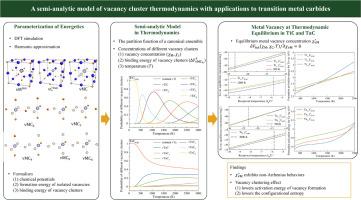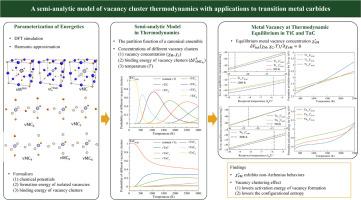A semi-analytic model of vacancy cluster thermodynamics with applications to transition metal carbides
IF 9.3
1区 材料科学
Q1 MATERIALS SCIENCE, MULTIDISCIPLINARY
引用次数: 0
Abstract
Vacancies are well known to alter a wide range of material properties from electrical conductivity to creep rates. However, there is a dearth of understanding of how vacancy clustering occurs in compounds where vacancy clustering is significant which is highlighted in the B1 structure transition metal carbides. In this study, we present a semi-analytical model for vacancy cluster thermodynamics, which accounts for both isolated vacancies and vacancy clusters by minimizing the total Helmholtz free energy. This approach enables the prediction of equilibrium vacancy concentrations while incorporating configurational entropy and temperature-dependent formation energetics. The model is then applied to two B1-structured transition metal carbides, and , where the isolated vacancy formation energies and vacancy-cluster binding energies are determined using density functional theory (DFT) calculations. Contributions from vibrational and electronic entropies are also included, which highlights the different bonding in group IVB and VB monocarbides. The results suggest that metal vacancy concentration at thermodynamic equilibrium exhibits a non-Arrhenius behavior since vacancy-cluster formation not only changes the formation energy but also significantly lowers the configurational entropy. This means that the formation of metal vacancies depends on both the temperature and the carbon vacancy concentration, which provides insights into the self-diffusion mechanism in transition metal carbides. Furthermore, the theory presented here can be applied to a wide range of materials to understand the role vacancy clustering in compounds.


空位团簇热力学半解析模型及其在过渡金属碳化物中的应用
众所周知,空缺可以改变从电导率到蠕变速率的各种材料性能。然而,在B1结构过渡金属碳化物中,缺乏对空位团簇如何在空位团簇显著的化合物中发生的理解。在这项研究中,我们提出了一个空缺团簇热力学的半解析模型,该模型通过最小化总亥姆霍兹自由能来解释孤立空缺和空缺团簇。这种方法可以预测平衡空位浓度,同时结合构型熵和温度依赖的形成能量学。然后将该模型应用于两种b1结构的过渡金属碳化物TiC和TaC,使用密度泛函理论(DFT)计算确定了孤立空位形成能和空位簇结合能。振动熵和电子熵的贡献也包括在内,这突出了IVB族和VB族单碳化物的不同成键。结果表明,在热力学平衡下的金属空位浓度表现出非阿伦尼乌斯行为,空位团簇的形成不仅改变了形成能,而且显著降低了构型熵。这意味着金属空位的形成取决于温度和碳空位浓度,这为过渡金属碳化物的自扩散机制提供了新的见解。此外,本文提出的理论可以应用于广泛的材料,以了解化合物中空位簇的作用。
本文章由计算机程序翻译,如有差异,请以英文原文为准。
求助全文
约1分钟内获得全文
求助全文
来源期刊

Acta Materialia
工程技术-材料科学:综合
CiteScore
16.10
自引率
8.50%
发文量
801
审稿时长
53 days
期刊介绍:
Acta Materialia serves as a platform for publishing full-length, original papers and commissioned overviews that contribute to a profound understanding of the correlation between the processing, structure, and properties of inorganic materials. The journal seeks papers with high impact potential or those that significantly propel the field forward. The scope includes the atomic and molecular arrangements, chemical and electronic structures, and microstructure of materials, focusing on their mechanical or functional behavior across all length scales, including nanostructures.
 求助内容:
求助内容: 应助结果提醒方式:
应助结果提醒方式:


